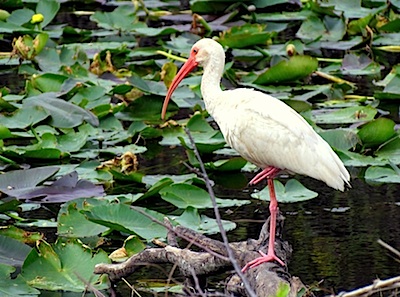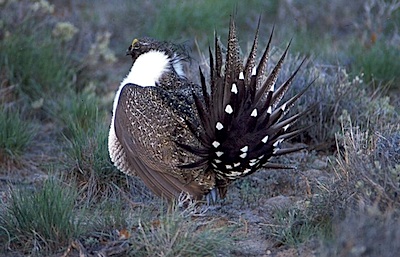
A White Ibis spotted in Big Cypress National Preserve. Kirby Adams photo.
As reported here Sunday, the National Audubon Society designated areas around Canyonlands National Park a Globally Important Bird Area (IBA). Parts of more than 15 other national parks are included in the Global IBA system.
The Important Bird Areas Program is an initiative of the international conservation partnership BirdLife International. The program aims to identify and conserve areas that are vital to birds and other biodiversity. In each country affiliated with BirdLife International, a partner in conservation implements and administers the program on the national level. In the United States that duty falls to the National Audubon Society.
The criteria for selection as a Global IBA are strict and subject to rigorous science. The four categories that a Global IBA can fall into (often with overlap) are: Globally threatened Species, Range-restricted Species, Biome-restricted Species, or a Congregation site (applicable only to waterbirds.) Within each category, there are specific thresholds to be met that may seem arbitrary at a glance, but are based on decades of conservation science.
For example, in the Range-restricted Category, a Globally Important Bird Area must have two species within the area that both have a global distribution of less than 50,000 km2. As many as 70 percent of those species are likely to qualify the site as a Global IBA under the Globally Threatened category as well.
In the Congregations category, a site must be known to hold (on a regular basis) 1 percent or more of the biogeographic population of a waterbird species. The White Ibis is not considered a threatened, endangered, or rare species. However, with a large number of nests (more than 7,000, to be precise) in a narrow strip along the Tamiami Trail on the north edge of Everglades National Park, that spot is triggered as a Global IBA. A loss of that fragile habitat could have a sudden and disastrous effect on the population of a bird that is currently doing fine. Coincidentally, the North Everglades IBA is one of 334 Global IBA’s designated as “Important Bird Areas in Danger” by BirdLife International because of severe pressure from development, habitat degradation, climate change, or other factors. Seven of those sites are in the United States.
While National Audubon determines areas of global priority, state Audubon chapters are tasked with selection of areas that may not meet criteria as Global IBA’s, but still merit inclusion in the program as State IBA’s. Apostle Islands National Lakeshore, Great Basin National Park, Dry Tortugas National Park and the Wyoming portion of Yellowstone National Park are all part their respective states’ IBA programs. Those areas are considered essential habitat for at least several birds that are regionally threatened or rare.
Great Smoky Mountains National Park is cleanly split with the Tennessee side being a Global IBA and the North Carolina side a State IBA. The Tennessee side, part of the Southern Blue Ridge IBA, triggered global priority thanks to the presence of the threatened Golden-winged Warbler.
Piping Plovers triggered global priority for Cumberland Island, Cape Lookout, Cape Hatteras, and Assateague Island national seashores, as well as the Jamaica Bay area of Gateway National Recreation Area. While Piping Plover habitat management programs implemented by the National Park Service have led to much consternation and legal wrangling, particularly at Cape Hatteras, the NPS is acting under the federal Endangered Species Act (ESA). The National Audubon Society has joined in legal action regarding nest closures, with the IBA designation in mind, but arguing for action adhering to the ESA as the IBA is legally non-binding.

This Greater Sagegrouse calls Craters of the Moon National Monument in Idaho home. NPS photo.
Far less conflict exists with the Great Lakes Population of the endangered Piping Plover where Sleeping Bear Dunes National Lakeshore is a Global IBA and the NPS oversees plover habitat protection largely without incident.
Significant portions of both Big Cypress National Preserve and Everglades National Park are included in the Big Cypress Watershed Global IBA. The triggering species in this area is the endangered Red-cockaded Woodpecker.
California Condors are arguably the most famous endangered bird in North America and unquestionably in severe peril. Release areas for the captive breeding program for condors have been selected for habitat suitability and high levels of long-term protection. Zion and Grand Canyon national parks fit that bill perfectly, and have been designated as Global IBA’s accordingly.
In southeastern Arizona, Chiricahua National Monument and the surrounding area joins Canyonlands National Park in Utah as a Global IBA for protection of the Spotted Owl. The Chiricahua Mountains IBA also encompasses Cave Creek Canyon and other parts of the Coronado National Forest that are among the most famous birding sites in the United States, thanks to the unique biogeographical habitat and proximity to Mexico.
In the Northern Rocky Mountain region, Craters of the Moon National Monument and Preserve IBA holds the endangered Greater Sage-grouse, while Glacier National Park is designated for the threatened Olive-sided Flycatcher.
Point Reyes National Seashore is a popular birding destination during migration, but only received global priority IBA status thanks to the Ashy Storm-petrel, an endangered seabird dependant on the nutrient-rich California Current. Ashy Storm-petrels are also one of the species triggering global priority for Channel Islands National Park. They are joined as trigger species at Channel Islands by Brown Pelican (congregation), Heerman’s Gull (rarity), Island Scrub Jay (rarity), Pink-footed Shearwater (rarity, congregation), Sooty Shearwater (rarity), and Xantu’s Murrelet (rarity and congregation).
The Mauna Loa – Kilauea Forests Global IBA (including much of Hawaii Volcanoes National Park) is also triggered by seven species, all for scarcity: Akepa, Akiapolaau, Elepaio, Hawaii Creeper, Hawaiian Goose, Iiwi, and Omao. These Hawaiian endemics are among the most vulnerable of any birds in the United States, in part because of their restricted island range.
The southern coast of Alaska is a conglomeration of a nearly contiguous string of Global IBA’s, many falling into the waterbird congregation category. Parts of Kenai Fjords, Wrangell-St. Elias, Denali, and Glacier Bay national parks are covered by one or more IBA’s.
It follows that an area designated as an Important Bird Area, would also be a great birding area. The IBA roster reads like a list of popular birding destinations in the United States. To check out some of the 2,682 Important Bird Areas in the United States, visit the interactive IBA map site.



Add comment